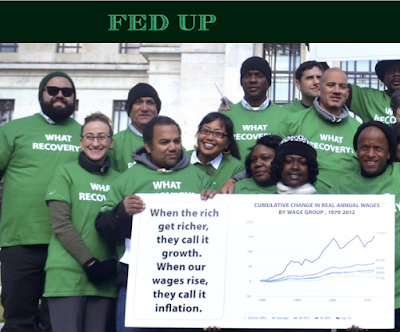Now the Fed has received an activist group at its annual Jackson Hole symposium to hear their views on monetary policy. This week, a movement called “Fed Up” sponsored by The Center for Popular Democracy met with Federal Reserve officials including Bill Dudley, president of the Federal Reserve Bank of New York.
The Fed Up team merits an A grade for inventiveness. Such groups often petition the legislative and executive branches of government that control spending and tax policy, but now one has successfully lobbied the The Federal Reserve within spitting distance. To be fair, the group had some trained economists in their midst and they did nothing disruptive; but do political organizations belong at this annual forum?
 |
http://whatrecovery.org/ website
|
The Fed's annual meeting shouldn't become a town hall with listening sessions like one conducted by your local Congressman.
I haven't seen any reporting of the Fed Up attendees causing problems at Jackson Hole, but Fed officials' willingness to receive them in the first place is unsettling.
After all, if Fed "independence" is advanced by the number of constituencies it receives in public, they must receive all comers. Ultra low interest rates and
massive bond buying by the Fed have juiced the stock market, but also crushed returns for elderly people living on payments from fixed income investments and cash.
Therefore, should the AARP or another group representing retirees have been granted equal time at Jackson Hole to advocate for monetary tightening?















